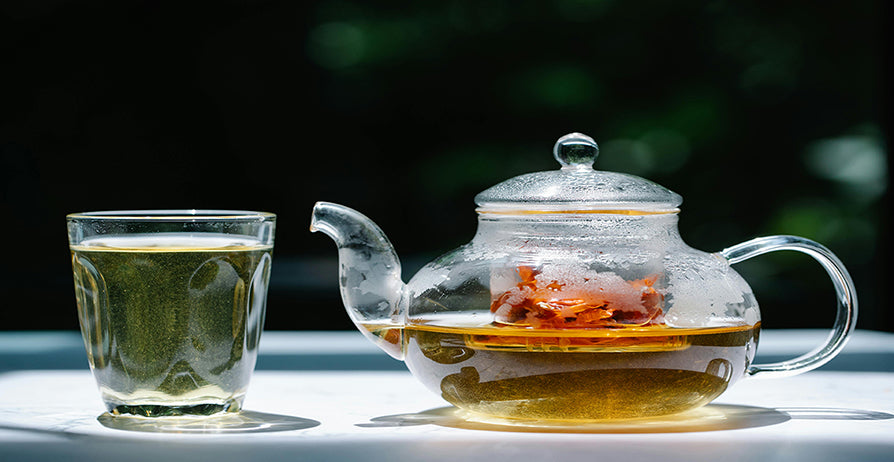
Green Tea Brewing Essentials: A Beginner's Guide
Share
Introduction
Brewing a perfect cup of tea doesn't have to be complicated or time-consuming. In fact, with just below-boiling water and a tea infuser, you can enjoy the superior flavor and health benefits of loose-leaf tea without any hassle. Many people think that using loose-leaf tea is difficult, but it's quite the opposite. Let's demystify the process and make your tea time as enjoyable and straightforward as possible.
Choosing the Right Tea
The journey to a perfect cup begins with choosing the right tea. There are various types of tea, including green, black, oolong, white, and herbal teas. Each type offers unique flavors and benefits, so it’s important to explore and find what suits your taste. Always opt for high-quality, whole-leaf teas, as they provide a richer and more nuanced flavor compared to tea bags filled with dust and fannings.
Key Tips for Perfect Tea Brewing
Brewing loose-leaf tea is simple and doesn't require a lot of specialized equipment. Here are the basics to get you started:
1. High-Quality Water: The most important ingredient in your tea is the water. Use fresh, filtered water to ensure the best flavor.
2. Infusers and Ceramic Cups: For loose-leaf tea, a fine mesh infuser or strainer is essential. Invest in a good ceramic cup with an infuser, which will help you enjoy the full flavor of the tea leaves without the mess. It's a cost-effective and eco-friendly alternative to tea bags.
3. No Fancy Tools Needed: You don't need any special measuring tools. Just use your intuition to scoop the right amount of tea leaves. With a little practice, you'll find what works best for you and brew a perfect cup every time.
Water Quality and Temperature
Water is a crucial component of tea. Use filtered or spring water for the best results. Different teas require different water temperatures:
- Green Tea: 70-80°C (160-175°F)
- Black Tea: 90-100°C (195-212°F)
- Oolong Tea: 80-90°C (175-195°F)
- White Tea: 70-80°C (160-175°F)
- Herbal Tea: 90-100°C (195-212°F)
Using the correct temperature ensures that you extract the best flavors without burning the leaves or leaving them under-extracted.
Measuring the Tea
Proper tea-to-water ratio is essential for a balanced cup. Generally, use one teaspoon (about 2 grams) of loose-leaf tea per 8-ounce (~220 ml) cup of water. For stronger tea, add more leaves rather than increasing steeping time, which can make the tea bitter.
Steeping Time
Steeping time varies depending on the type of tea:
- Green Tea: 2-3 minutes
- Black Tea: 3-5 minutes
- Oolong Tea: 3-5 minutes
- White Tea: 4-5 minutes
- Herbal Tea: 5-7 minutes
Over-steeping can make the tea bitter, while under-steeping might result in a weak flavor. Use a timer to achieve the perfect steep.
Serving and Enjoying Tea
Once your tea is perfectly brewed, pour it gently into your cup. Using the right teaware can enhance the experience. For instance, using a good ceramic cup with a ceramic infuser can enhance your tea time and make the experience feel special. Set a calming environment, perhaps with soft music or a serene view, to truly savor your tea.
Avoiding Common Mistakes (with a Dash of Humor)
Please Stop Boiling Green Tea Leaves on the Stove? Let's Talk!
Okay, let's have a little chat. If you've been tossing your green tea leaves into a boiling saucepan on the stove, we need to stop this tea travesty right now!
Boiling green tea leaves is like taking a fine piece of art and dunking it in paint thinner. Not ideal, right? What happens is that the delicate leaves get overcooked, resulting in a bitter brew that's a far cry from the refreshing, nuanced cup you deserve.
Instead, here's the magic formula: Heat your water to around 80°C (175°F), which is just below boiling. Then, pour the hot water over the leaves in your cup or teapot and let them steep gently. Trust us, your taste buds will thank you!
Conclusion
Brewing tea is a personal and enjoyable ritual. By paying attention to the type of tea, equipment, water quality, and brewing time, you can elevate your tea experience. Experiment and find what works best for you, and most importantly, enjoy every sip. Happy brewing!
